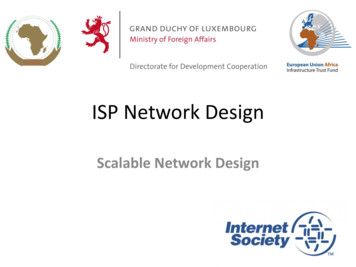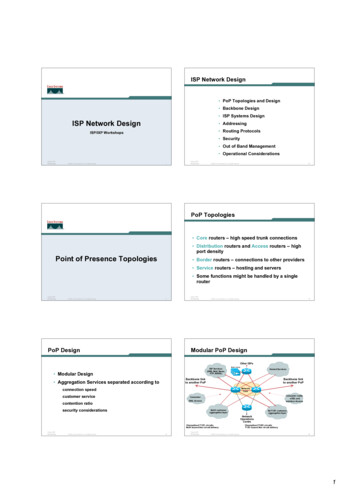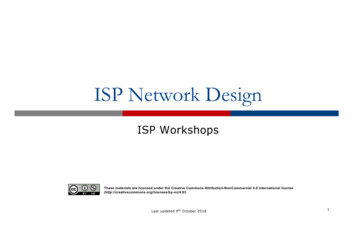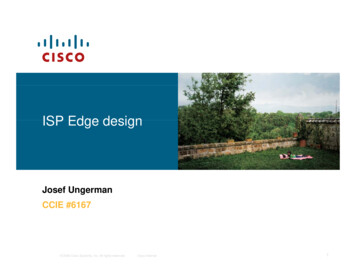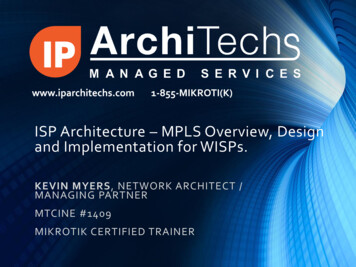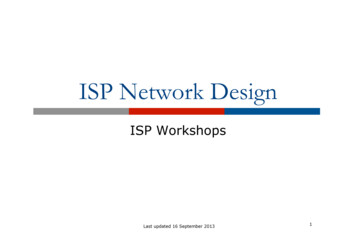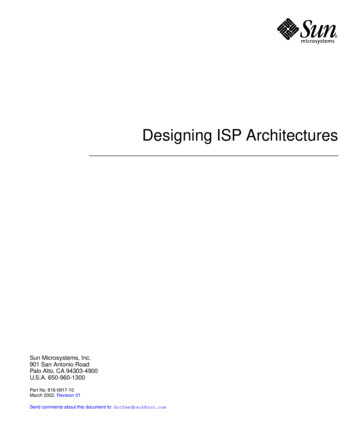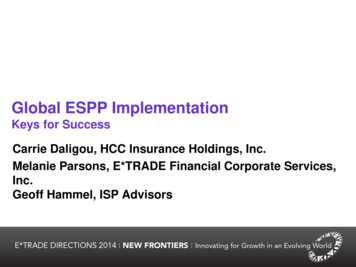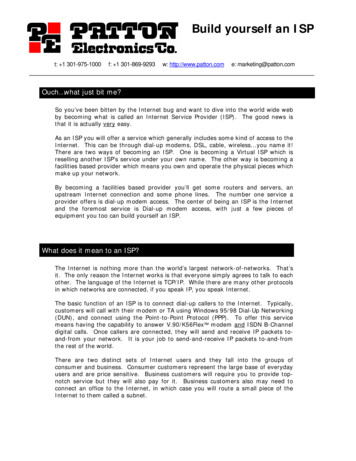
Transcription
Build yourself an ISPt: 1 301-975-1000f: 1 301-869-9293w: http://www.patton.come: marketing@patton.comOuch what just bit me?So you’ve been bitten by the Internet bug and want to dive into the world wide webby becoming what is called an Internet Service Provider (ISP). The good news isthat it is actually very easy.As an ISP you will offer a service which generally includes some kind of access to theInternet. This can be through dial-up modems, DSL, cable, wireless.you name it!There are two ways of becoming an ISP. One is becoming a Virtual ISP which isreselling another ISP’s service under your own name. The other way is becoming afacilities based provider which means you own and operate the physical pieces whichmake up your network.By becoming a facilities based provider you’ll get some routers and servers, anupstream Internet connection and some phone lines. The number one service aprovider offers is dial-up modem access. The center of being an ISP is the Internetand the foremost service is Dial-up modem access, with just a few pieces ofequipment you too can build yourself an ISP.What does it mean to an ISP?The Internet is nothing more than the world’s largest network-of-networks. That’sit. The only reason the Internet works is that everyone simply agrees to talk to eachother. The language of the Internet is TCP/IP. While there are many other protocolsin which networks are connected, if you speak IP, you speak Internet.The basic function of an ISP is to connect dial-up callers to the Internet. Typically,customers will call with their modem or TA using Windows 95/98 Dial-Up Networking(DUN), and connect using the Point-to-Point Protocol (PPP). To offer this servicemeans having the capability to answer V.90/K56Flex modem and ISDN B-Channeldigital calls. Once callers are connected, they will send and receive IP packets toand-from your network. It is your job to send-and-receive IP packets to-and-fromthe rest of the world.There are two distinct sets of Internet users and they fall into the groups ofconsumer and business. Consumer customers represent the large base of everydayusers and are price sensitive. Business customers will require you to provide topnotch service but they will also pay for it. Business customers also may need toconnect an office to the Internet, in which case you will route a small piece of theInternet to them called a subnet.
Build yourself an ISPt: 1 301-975-1000f: 1 301-869-9293w: http://www.patton.come: marketing@patton.comWhat you need to become a facilities based ISP.the view from 25,000 feetThere are actually very few pieces to the ISP puzzle. By breaking up the ISP’snetwork infrastructure into three distinct areas, we can easily see where each piecefits. The three areas are (see picture below):1)Access NetworkThis is where access services are added. Forexample, these can be remote access serversfor terminating dial-up modems or DSL modemsfor leased-line connections.2)Distribution Network This is where your backbone services connect toyour access network. Ethernet defines the ISP’s“backbone” and glues everything together.3)Core NetworkThis part is responsible for the connection to theWide-Area-Network.In our case it is theInternet.As the Internet is a network-ofnetworks, this connection is simply to anotherISP.Remote Access ServersDistributionAccessT1/E1/PRI Dial-In Trunks from the TelcoLocal ServersEthernet SwitchDNSRADIUSemailWWW/FTPNewsCoreData T1/E1/DSL to Upstream ISPSeriesCSU/DSU/NTUCisco 2501 Router
Build yourself an ISPt: 1 301-975-1000f: 1 301-869-9293w: http://www.patton.come: marketing@patton.comThe first piece of equipment to consider is the Ethernet switch. As the backbone ofthe ISP, Ethernet is the common denominator which permits different vendors’equipment to interconnect. It is through Ethernet that every piece of equipment willbe able to communicate with each other. Even in the largest ISPs of the world,Ethernet is the glue which links everything together. From this distribution point, anISP can add access services as well as additional upstream bandwidth.The ISP’s access network is the point where users connect for service. The mostcommon way is through dial-up modems. In the old days of Bulletin Board’s,standalone modems and terminal servers were the standard way of getting on-line.Now, with low cost T1/E1 lines and high-speed V.90 modems, an integrated boxprovides the best solution. This box is called a Remote Access Server (RAS).The RAS connects to the local phone company through a T1/E1 or PRI line and toyour local Ethernet switch. When users call to get on-line, the RAS is the box thatwill answer the call with a modem. After a dial-in user connects, the RAS will take IPpackets and send them off to the Internet. Here is how a remote access serverworks:1) A user dials the ISP’s access phone number using theirModem/Terminal Adapter and Windows 95/98 DUN. Thecall is answered by the RAS with a modem.2) Once the modems connect, a PPP session starts betweenthe user and the RAS.3) Through PPP, the RAS obtains the username and password.This is the same username and password that was typed inbefore dialing the ISP.4) The RAS queries a RADIUS server and asks to authenticatethe user.5) Assuming the user is valid, the RAS will automatically issuean IP address to the user and finish setting up theconnection. The user is now connected and can surf, email,and so on.The next piece of equipment is the router. This router will connect your network toyour upstream provider. It is through this provider that you will ultimately connectto other networks and hosts.or in other words the Internet. An upstream providerisn’t anything special, it is just another ISP selling Internet services to you. As anISP, if you were to route a subnet to another user or ISP, then you would be thatISP’s upstream provider.What an upstream provider really does is give you a subnet of IP addresses (usually256) and routes packets to-and-from your upstream router. For most smaller ISPsthis router is usually a Cisco 2501 (or equivalent variant). A CSU/DSU or NTU
Build yourself an ISPt: 1 301-975-1000f: 1 301-869-9293w: http://www.patton.come: marketing@patton.comconnects the router to a T1/E1 line or DSL line. The other end of this T1/E1/DSL lineterminates at your providers nearest point-of-presence.Next you will need to add some servers. The basic services which any ISP will needto provide are:1) DNSPrimary/Secondary Domain Name Resolution2) RADIUSUser Authentication and Accounting3) WWWBasic web server functionality4) EMAILProviding POP3/IMAP4 and SMTP servicesDNS is the method which computers translate names such as www.yahoo.com into anIP address. This is done because all Internet traffic is based on IP addresses, namesare only for humans. As an ISP you will need your own local DNS servers for yourcustomers to use.RADIUS stands for Remote Authentication Dial-In User Service. RADIUS is theauthentication protocol in which a client, such as a RAS, will ask a RADIUS server tovalidate a caller. User names and passwords as well as additional parameters arekept in a centralized database. RADIUS Accounting tracks Authentication andAuthorization transactions and captures statistics about each session. There aremany free RADIUS servers available on the web, and many ISP Billing systemsincorporate RADIUS support within their package.Email and web hosting are the most basic and most important parts of the ISP’sservice portfolio. These servers will store-and-forward email addressed to yourcustomers. Web hosting is now so common that it is frequently included as part of abasic access package. All of the necessary software is free on the web and oftencomes pre-installed with your operating system. Alternatively, Email/WWW/FTPservices can be done with a special server such as the Cobalt Networks RAQ(http://www.cobalt.com).This server takes care of all the configuration andmaintenance and has an excellent web interface.While all four services can be done on one server, good network engineering dictatesspreading them across two or three servers. This allows backup services onalternate servers. Your customers will expect your service to be available 24 hours aday.without a hitch.
Build yourself an ISPt: 1 301-975-1000f: 1 301-869-9293w: http://www.patton.come: marketing@patton.comThe view from ground zeroService Providers have been around since the early days of Bulletin Boards. Now, theInternet represents a new communications service market. Mass appeal and low costhave made it easy to become a facilities based provider. With just a few pieces ofequipment and some free software, it has never been easier to build yourself an ISP.A complete ISP InstallationEthernet SwitchUpstream RouterNote: CSU/DSU islocated at the rearof the routerRemote Access ServerThis is a picture of aworking ISP whichsupports about 1,600subscribers. It isinstalled in a co-locationfacility and has a 1.5mbps connection to itsupstream provider.As this ISP grew itadded additionalRemote Access Serversas well as an additionalrouter for point-to-pointconnections.Local Server forDNS & RADIUSAdditional ResourcesScott Whittle, Patton Electronics azing.comMaintains a large collection of ISP related materialshttp://www.internet.comA site focusing on the business aspects of being a service providerhttp://www.isp-lists.comMaintains ISP related discussion groupsAnd the link of all links http://www.howtosell.net/html/links.html
The ISP’s access network is the point where users connect for service. The most common way is through dial-up modems. In the old days of Bulletin Board’s, standalone modems and terminal servers were the standard way of getting on-line. Now, with low cost T1/E1 lines and high-speed V.90 modems, an integrated box


